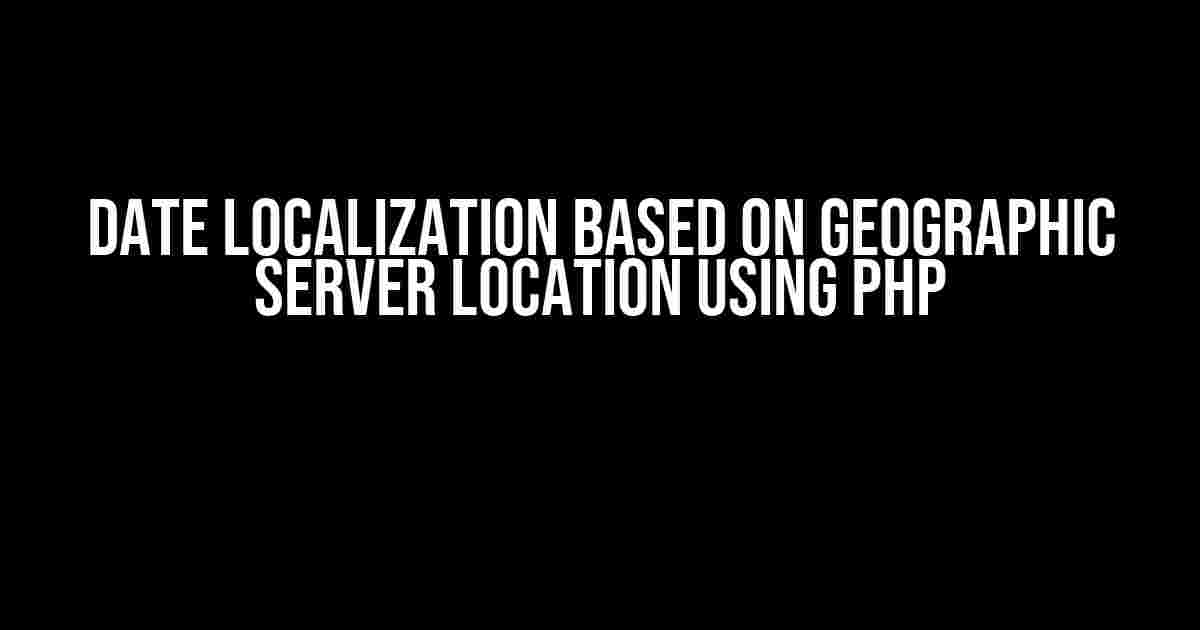Welcome to this comprehensive guide on date localization based on geographic server location using PHP! In today’s digital age, catering to a global audience has become a necessity for businesses and websites alike. One crucial aspect of providing a personalized experience is displaying dates in a format familiar to your users. In this article, we’ll delve into the world of date localization and explore how to achieve it using PHP, taking into account the geographic server location.
Why Date Localization Matters
Imagine visiting a website that displays dates in a format that’s foreign to you. It’s frustrating, to say the least. Date localization ensures that your website adapts to the user’s region, providing a more intuitive and user-friendly experience. This attention to detail can make a significant difference in user engagement and conversion rates.
The Problem with Hard-Coded Dates
Many developers fall into the trap of hard-coding dates in their PHP applications. This approach might seem straightforward, but it’s severely limited. Hard-coded dates ignore the user’s geographic location, leading to confusion and potential errors. Moreover, maintenance becomes a nightmare when you need to update dates across an entire application.
Geographic Server Location: The Magic Behind Date Localization
To achieve true date localization, we need to determine the user’s geographic server location. This can be accomplished using various methods, including:
- IP Geolocation APIs
- Browser Language Detection
- Server-Side Geolocation
In this article, we’ll focus on using IP Geolocation APIs, as they provide the most accurate results.
IP Geolocation APIs: A Brief Overview
IP Geolocation APIs use a user’s IP address to determine their geographic location. This information is then used to set the correct time zone, language, and date format. Some popular IP Geolocation APIs include:
| API | Accuracy | Pricing |
|---|---|---|
| MaxMind | 99.8% | Free (limited), Paid (premium) |
| IP2Location | 99.5% | Free (limited), Paid (premium) |
| IPInfo | 99.2% | Free (limited), Paid (premium) |
In this example, we’ll use the MaxMind API, as it offers a free version with limited requests.
Getting Started with PHP and MaxMind
Before we dive into the code, make sure you have:
- A MaxMind account with API credentials
- PHP 7.2 or higher installed on your server
- The Guzzle HTTP client library installed via Composer
Create a new PHP file, e.g., `date_localization.php`, and add the following code:
<?php require 'vendor/autoload.php'; use GuzzleHttp\Client; $client = new Client(); $api_key = 'YOUR_MAXMIND_API_KEY'; $ip_address = $_SERVER['REMOTE_ADDR']; $url = 'https://geolite.info/geoip/v2.1/city?ip=' . $ip_address . '&key=' . $api_key; $response = $client->get($url); $json_response = json_decode($response->getBody(), true); $timezone = $json_response['location']['time_zone']; date_default_timezone_set($timezone); ?>
This code sends a GET request to the MaxMind API, passing the user’s IP address and API key. The response is then decoded, and the time zone is extracted. Finally, we set the default time zone using the `date_default_timezone_set()` function.
Formatting Dates for Localization
Now that we have the user’s time zone, let’s format dates accordingly. PHP provides an excellent `DateTime` class for working with dates.
<?php
$date = new DateTime();
// Format date for the user's region
$localized_date = $date->format('M j, Y g:i A');
echo $localized_date;
?>
In this example, we create a new `DateTime` object and format the date using the `format()` method. The format string `M j, Y g:i A` corresponds to:
- `M`: Short month name (e.g., Jan)
- `j`: Day of the month without leading zeros (e.g., 1-31)
- `Y`: Full year (e.g., 2023)
- `g`: Hour in 12-hour format without leading zeros (e.g., 1-12)
- `i`: Minutes with leading zeros (e.g., 00-59)
- `A`: AM/PM designation (e.g., AM or PM)
Working with Different Date Formats
What if you need to display dates in different formats, such as:
- British English (dd/mm/yyyy)
- European (dd.mm.yyyy)
- American (mm/dd/yyyy)
We can create an array of date formats and use the user’s region to determine the correct format:
<?php
$date_formats = array(
'en_GB' => 'd/m/Y', // British English
'de_DE' => 'd.m.Y', // European
'en_US' => 'm/d/Y', // American
);
$region = $json_response['location']['country']['iso_code'];
if (array_key_exists($region, $date_formats)) {
$date_format = $date_formats[$region];
$localized_date = $date->format($date_format);
echo $localized_date;
} else {
echo 'Unsupported region';
}
?>
In this example, we create an array of date formats, where the key is the region’s ISO code and the value is the corresponding date format. We then use the user’s region to retrieve the correct date format and display the localized date.
Putting it All Together
Now that we have the necessary components, let’s combine them into a single PHP file:
<?php
require 'vendor/autoload.php';
use GuzzleHttp\Client;
$client = new Client();
$api_key = 'YOUR_MAXMIND_API_KEY';
$ip_address = $_SERVER['REMOTE_ADDR'];
$url = 'https://geolite.info/geoip/v2.1/city?ip=' . $ip_address . '&key=' . $api_key;
$response = $client->get($url);
$json_response = json_decode($response->getBody(), true);
$timezone = $json_response['location']['time_zone'];
date_default_timezone_set($timezone);
$date_formats = array(
'en_GB' => 'd/m/Y', // British English
'de_DE' => 'd.m.Y', // European
'en_US' => 'm/d/Y', // American
);
$region = $json_response['location']['country']['iso_code'];
if (array_key_exists($region, $date_formats)) {
$date_format = $date_formats[$region];
$date = new DateTime();
$localized_date = $date->format($date_format);
echo $localized_date;
} else {
echo 'Unsupported region';
}
?>
This code retrieves the user’s geographic location, sets the correct time zone, and formats the date according to their region.
Conclusion
In this comprehensive guide, we’ve explored the importance of date localization based on geographic server location using PHP. By leveraging IP Geolocation APIs like MaxMind, we can provide a more personalized experience for our users. Remember to adapt your code to cater to different regions and date formats, ensuring a seamless experience for your global audience.
Happy coding!
Frequently Asked Questions
Get answers to your most pressing questions about date localization based on geographic server location using PHP!
How does date localization work based on geographic server location in PHP?
Date localization in PHP works by using the server’s geographic location to determine the correct date and time format. This is done by using the `date_default_timezone_set()` function to set the timezone based on the server’s location. For example, if the server is located in New York, the timezone would be set to `America/New_York`. This ensures that dates and times are displayed correctly for users in that region.
What is the importance of using date localization in PHP?
Using date localization in PHP is crucial because it ensures that dates and times are displayed correctly for users in different regions. This is especially important for websites that cater to international audiences, as it helps to avoid confusion and ensures that users receive accurate information. Additionally, date localization can also help to improve the user experience and increase engagement.
How do I determine the geographic location of my server in PHP?
You can determine the geographic location of your server in PHP by using the `geoip_country_code_by_name()` function, which returns the country code of the server’s IP address. Alternatively, you can use third-party libraries such as MaxMind’s GeoIP API to determine the server’s location.
Can I use date localization for other purposes besides displaying dates and times?
Yes, date localization can be used for other purposes beyond displaying dates and times. For example, it can be used to determine the correct holiday schedules, working hours, and even language preferences for users in different regions. This can help to create a more personalized and culturally relevant experience for users.
What are some best practices for implementing date localization in PHP?
Some best practices for implementing date localization in PHP include using the `DateTime` class to handle dates and times, using the `setLocale()` function to set the correct locale, and testing your implementation in different regions to ensure that it works correctly. Additionally, it’s also important to consider edge cases and handle errors gracefully to ensure that your implementation is robust and reliable.



